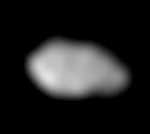|
|
Metis (IPA: /ˈmiːtɪs/, mee'-tis, Greek Μήτις) is the innermost member of the Jupiter's small inner moons. The moon was discovered in 1979 by the Voyager 1 probe and was designated S/1979 J 3. In 1983 it was officially named after the mythological Metis, a Titaness who was the first wife of Zeus and the mother of Athena. It is also designated Jupiter XVI. Metis lies within Jupiter's main planetary ring, and may be the source of the material that comprises it. Its orbit lies inside Jupiter's synchronous orbit radius (as does Adrastea's), and as a result, tidal forces are slowly causing its orbit to decay. It is also within its density's fluid Roche limit, but not its rigid Roche limit, and so avoids tidal disruption. Metis, the moon of Jupiter, is not to be confused with the asteroid 9 Metis.
Jupiter's natural satellitesedit Inner satellites | Galilean moons: Io, Europa, Ganymede, and Callisto | Themisto | Himalia group | Carpo | S/2003 J 12 | Ananke group | Carme group | Pasiphaë group | S/2003 J 2 Retrieved from "http://en.wikipedia.org/" All text is available under the terms of the GNU Free Documentation License
|
|
|||||||||||||||||||||||||||||||||||||||||||||||||||||||||||||||||||||||||
|
Contact - Search - Statistics |
